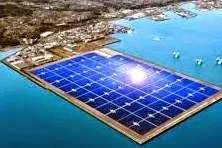The construction on a 2.3-megawatt floating solar power plant has been
completed on Sunday in Hyogo prefecture, western Japan, which is the
world's largest floating solar power plant in terms of output.
The plant, coinvested by electronics giant Kyocera Corporation and Century Tokyo Leasing Corporation, is expected to generate 2, 680 megawatt hours (MWh) every year.
According to Kyocera, floating solar plants are superior to their land-based equivalents because of the cooling effects of the water, which allow the plants to have better power generating efficiency.
"As solar power is booming in Japan, land available for large solar plants is hard to come by, and solar power generation on water surfaces attracts more and more attention," said Ichiro Ikeda, general manager of Kyocera's solar energy marketing division.
"Besides higher efficiency, photovoltaic panels floating on the water could produce shades and reduce water evaporation and restrain algae growth, which is good for reservoirs," he added.
The Japanese government has been vigorously promoting development of renewable power generation such as solar power since the 2011 Fukushima Nuclear disaster caused a power shortage around the country.
Source:Xinhua - globaltimes.cn
24/5/15
--
-
The plant, coinvested by electronics giant Kyocera Corporation and Century Tokyo Leasing Corporation, is expected to generate 2, 680 megawatt hours (MWh) every year.
According to Kyocera, floating solar plants are superior to their land-based equivalents because of the cooling effects of the water, which allow the plants to have better power generating efficiency.
"As solar power is booming in Japan, land available for large solar plants is hard to come by, and solar power generation on water surfaces attracts more and more attention," said Ichiro Ikeda, general manager of Kyocera's solar energy marketing division.
"Besides higher efficiency, photovoltaic panels floating on the water could produce shades and reduce water evaporation and restrain algae growth, which is good for reservoirs," he added.
The Japanese government has been vigorously promoting development of renewable power generation such as solar power since the 2011 Fukushima Nuclear disaster caused a power shortage around the country.
Source:Xinhua - globaltimes.cn
24/5/15
--
-

Floating Solar Power Systems are wonderful Ideas. And it’s very important to maintain effectively same direction and position on the water for floating solar plants. Because directional change of solar panels reduces electricity production. So floating solar plants also need the directional control mooring systems for their parked positions. Azimuth and position change of floating solar plants caused by wind, waves and external forces. Restoring Force Strengthened Mooring System for floating solar plants has been created in South Korea. This Mooring System generates Restoring Force immediately when floating solar plants are being rotated or moved on the water.
ReplyDeleteIn addition, you have to reduce vibration to install floating solar plants. Because, it can make micro-cracks to floating solar panels and the durability problem of floating solar plants. The risk of power loss in PV modules due to micro cracks is increasing.
Vibrations caused by wind, waves and external forces. New Type Floating Body Stabilizer has been created in South Korea. The Floating Body Stabilizers generate drag force immediately when floating solar plants are being rolled, pitched and yawed on the water.
Recently, Restoring Force Strengthened Mooring Systems and Floating Body Stabilizers have been used for floating solar plants in South Korea.
You can see them in Ochang Dam, South Korea. I N I WORLD